Integrating Meteorological Forcing from Ground Observations and MSWX Dataset for Streamflow Prediction under Multiple Parameterization Scenarios
Abstract
:1. Introduction
2. Materials and Methods
2.1. Study Area
2.2. Data
2.3. TUW Hydrologic Model and Streamflow Simulation Scenarios
2.4. Evaluation Approach
3. Result and Discussion
3.1. Evaluation of Meteorological Data at the Regional Scale
3.2. Reliability and Detectability Strength of MSWXv100 Dataset at Daily Time Step
3.3. Streamflow Simulation under Individual Model Parameterization Scenarios
3.3.1. Calibration of Model Parameters and Uncertainty Analysis
3.3.2. Streamflow Simulation with 95PPU
4. Summary and Conclusions
- Overall, MSWX-based temperature data show high performance (median of KGE > 0.90) when compared with observed temperatures directly. Among temperatures, the MSWX average temperature shows the highest performance (median of KGE; 0.97) on the regional scale. Compared to other meteorological forcing, MSWX-based precipitation shows lower performance (median KGE of 0.53) for the daily time step at the regional level. However, this is the only dataset which has the highest performance compared to previous studies over the Karasu basin for the daily time step. In the same way, MSWX based calculated PET shows high performance (median KGE of 0.93) for the study area.
- MSWX precipitation shows high detectability strength for moderate (5–20 mm/day) precipitation and its detectability strength decreases for heavy (20–40 mm/day) and violent (>40 mm/day) precipitation. MSWX precipitation showed a higher frequency of occurrence for light (1–5 mm/day) precipitation compared to observed precipitation, and the high frequency of occurrence directly affected MSWX detectability strength for the mentioned precipitation threshold.
- Considering 95PPU in model parameters, when the model is calibrated entirely by observed data (Scenario 1), it shows a relatively smaller range of uncertainty (95PPU) for most model parameters, whereas Scenario 4, which is entirely based on MSWX dataset, shows a slightly wider uncertainty bound (95PPU) for some parameters comparatively.
- When observed precipitation is considered for model calibration (Scenario 1, 3), the model shows high performance for streamflow simulation, where Scenario 2 and Scenario 4 show lower streamflow reproducibility, especially for the validation period. This can be attributed to the bias in MSWX precipitation datasets (Section 3.2), which shows direct effects on streamflow simulation. However, considering MSWX precipitation in different scenarios, it shows acceptable performance for streamflow reproducibility.
Author Contributions
Funding
Institutional Review Board Statement
Informed Consent Statement
Data Availability Statement
Acknowledgments
Conflicts of Interest
References
- Haylock, M.; Hofstra, N.; Klein Tank, A.; Klok, E.; Jones, P.; New, M. A European daily high-resolution gridded data set of surface temperature and precipitation for 1950–2006. J. Geophys. Res. Atmos. 2008, 113, D20119. [Google Scholar] [CrossRef]
- Hofstra, N.; Haylock, M.; New, M.; Jones, P.; Frei, C. Comparison of six methods for the interpolation of daily, European climate data. J. Geophys. Res. Atmos. 2008, 113, D21. [Google Scholar] [CrossRef]
- Horner, I.; Branger, F.; McMillan, H.; Vannier, O.; Braud, I. Information content of snow hydrological signatures based on streamflow, precipitation and air temperature. Hydrol. Processes 2020, 34, 2763–2779. [Google Scholar] [CrossRef]
- Trenberth, K.E. Changes in precipitation with climate change. Clim. Res. 2011, 47, 123–138. [Google Scholar] [CrossRef]
- Hui, Y.; Zhang, Q.; Xu, C.-Y.; Xiong, L.; Chen, J.; Xie, P. Vegetation’s role in controlling long-term response of near ground air temperature to precipitation change in a semi-arid region. J. Arid Environ. 2018, 152, 83–86. [Google Scholar] [CrossRef]
- Prihodko, L.; Goward, S.N. Estimation of air temperature from remotely sensed surface observations. Remote Sens. Environ. 1997, 60, 335–346. [Google Scholar] [CrossRef]
- Berg, P.; Norin, L.; Olsson, J. Creation of a high resolution precipitation data set by merging gridded gauge data and radar observations for Sweden. J. Hydrol. 2016, 541, 6–13. [Google Scholar] [CrossRef]
- Shi, H.; Chen, J.; Li, T.; Wang, G. A new method for estimation of spatially distributed rainfall through merging satellite observations, raingauge records, and terrain digital elevation model data. J. Hydro-Environ. Res. 2020, 28, 1–14. [Google Scholar] [CrossRef]
- Hafizi, H.; Sorman, A.A. Assessment of Satellite and Reanalysis Precipitation Products for Rainfall–Runoff Modelling in a Mountainous Basin. Environ. Sci. Proc. 2021, 8, 25. [Google Scholar]
- Roth, V.; Lemann, T. Comparing CFSR and conventional weather data for discharge and soil loss modelling with SWAT in small catchments in the Ethiopian Highlands. Hydrol. Earth Syst. Sci. 2016, 20, 921–934. [Google Scholar] [CrossRef]
- Eini, M.R.; Javadi, S.; Delavar, M.; Monteiro, J.A.; Darand, M. High accuracy of precipitation reanalyses resulted in good river discharge simulations in a semi-arid basin. Ecol. Eng. 2019, 131, 107–119. [Google Scholar] [CrossRef]
- De Stefano, L.; Petersen-Perlman, J.D.; Sproles, E.A.; Eynard, J.; Wolf, A.T. Assessment of transboundary river basins for potential hydro-political tensions. Glob. Environ. Chang. 2017, 45, 35–46. [Google Scholar] [CrossRef]
- Hrachowitz, M.; Savenije, H.; Blöschl, G.; McDonnell, J.; Sivapalan, M.; Pomeroy, J.; Arheimer, B.; Blume, T.; Clark, M.; Ehret, U. A decade of Predictions in Ungauged Basins (PUB)—A review. Hydrol. Sci. J. 2013, 58, 1198–1255. [Google Scholar] [CrossRef]
- Nguyen, P.; Ombadi, M.; Gorooh, V.A.; Shearer, E.J.; Sadeghi, M.; Sorooshian, S.; Hsu, K.; Bolvin, D.; Ralph, M.F. PERSIANN Dynamic Infrared–Rain Rate (PDIR-Now): A Near-Real-Time, Quasi-Global Satellite Precipitation Dataset. J. Hydrometeorol. 2020, 21, 2893–2906. [Google Scholar] [CrossRef]
- Beck, H.E.; Wood, E.F.; Pan, M.; Fisher, C.K.; Miralles, D.G.; Van Dijk, A.I.; McVicar, T.R.; Adler, R.F. MSWEP V2 global 3-hourly 0.1 precipitation: Methodology and quantitative assessment. Bull. Am. Meteorol. Soc. 2019, 100, 473–500. [Google Scholar] [CrossRef]
- Funk, C.; Peterson, P.; Landsfeld, M.; Pedreros, D.; Verdin, J.; Shukla, S.; Husak, G.; Rowland, J.; Harrison, L.; Hoell, A. The climate hazards infrared precipitation with stations—a new environmental record for monitoring extremes. Sci. Data 2015, 2, 150066. [Google Scholar] [CrossRef]
- Beck, H.E.; van Dijk, A.I.; Larraondo, P.R.; McVicar, T.R.; Pan, M.; Dutra, E.; Miralles, D.G. MSWX: Global 3-hourly 0.1° bias-corrected meteorological data including near real-time updates and forecast ensembles. Bull. Am. Meteorol. Soc. 2021, 103, E710–E732. [Google Scholar] [CrossRef]
- Saha, S.; Moorthi, S.; Pan, H.-L.; Wu, X.; Wang, J.; Nadiga, S.; Tripp, P.; Kistler, R.; Woollen, J.; Behringer, D. The NCEP climate forecast system reanalysis. Bull. Am. Meteorol. Soc. 2010, 91, 1015–1058. [Google Scholar] [CrossRef]
- Zhang, Y.; Wu, C.; Yeh, P.J.-F.; Li, J.; Hu, B.X.; Feng, P.; Jun, C. Evaluation and comparison of precipitation estimates and hydrologic utility of CHIRPS, TRMM 3B42 V7 and PERSIANN-CDR products in various climate regimes. Atmos. Res. 2022, 265, 105881. [Google Scholar] [CrossRef]
- Bhati, D.S.; Dubey, S.K.; Sharma, D. Application of Satellite-Based and Observed Precipitation Datasets for Hydrological Simulation in the Upper Mahi River Basin of Rajasthan, India. Sustainability 2021, 13, 7560. [Google Scholar] [CrossRef]
- Gunathilake, M.B.; Zamri, M.N.M.; Alagiyawanna, T.P.; Samarasinghe, J.T.; Baddewela, P.K.; Babel, M.S.; Jha, M.K.; Rathnayake, U.S. Hydrologic Utility of Satellite-Based and Gauge-Based Gridded Precipitation Products in the Huai Bang Sai Watershed of Northeastern Thailand. Hydrology 2021, 8, 165. [Google Scholar] [CrossRef]
- Satgé, F.; Pillot, B.; Roig, H.; Bonnet, M.-P. Are gridded precipitation datasets a good option for streamflow simulation across the Juruá river basin, Amazon? J. Hydrol. 2021, 602, 126773. [Google Scholar] [CrossRef]
- Karakoc, U.; Patil, S. Comparison of TRMM satellite and ground-based precipitation data for predicting streamflow in Kucuk Menderes river basin, Turkey. In Proceedings of the EGU General Assembly Conference Abstracts, Vienna, Austria, 17–22 April 2016; p. EPSC2016-1467. [Google Scholar]
- Uysal, G.; Şorman, A.Ü. Evaluation of PERSIANN family remote sensing precipitation products for snowmelt runoff estimation in a mountainous basin. Hydrol. Sci. J. 2021, 66, 1790–1807. [Google Scholar] [CrossRef]
- Hafizi, H.; Sorman, A.A. Assessment of 13 Gridded Precipitation Datasets for Hydrological Modeling in a Mountainous Basin. Atmosphere 2022, 13, 143. [Google Scholar] [CrossRef]
- Satgé, F.; Defrance, D.; Sultan, B.; Bonnet, M.-P.; Seyler, F.; Rouché, N.; Pierron, F.; Paturel, J.-E. Evaluation of 23 gridded precipitation datasets across West Africa. J. Hydrol. 2020, 581, 124412. [Google Scholar] [CrossRef]
- Xu, J.; Ma, Z.; Yan, S.; Peng, J. Do ERA5 and ERA5-Land Precipitation Estimates Outperform Satellite-based Precipitation Products? A Comprehensive Comparison between State-of-the-art Model-based and Satellite-based Precipitation Products over Mainland China. J. Hydrol. 2021, 605, 127353. [Google Scholar] [CrossRef]
- Turini, N.; Thies, B.; Rollenbeck, R.; Fries, A.; Pucha-Cofrep, F.; Orellana-Alvear, J.; Horna, N.; Bendix, J. Assessment of Satellite-Based Rainfall Products Using a X-Band Rain Radar Network in the Complex Terrain of the Ecuadorian Andes. Atmosphere 2021, 12, 1678. [Google Scholar] [CrossRef]
- Beck, H.E.; Pan, M.; Roy, T.; Weedon, G.P.; Pappenberger, F.; Van Dijk, A.I.; Huffman, G.J.; Adler, R.F.; Wood, E.F. Daily evaluation of 26 precipitation datasets using Stage-IV gauge-radar data for the CONUS. Hydrol. Earth Syst. Sci. 2019, 23, 207–224. [Google Scholar] [CrossRef]
- Ghozat, A.; Sharafati, A.; Hosseini, S.A. Long-term spatiotemporal evaluation of CHIRPS satellite precipitation product over different climatic regions of Iran. Theor. Appl. Climatol. 2021, 143, 211–225. [Google Scholar] [CrossRef]
- Amjad, M.; Yilmaz, M.T.; Yucel, I.; Yilmaz, K.K. Performance evaluation of satellite-and model-based precipitation products over varying climate and complex topography. J. Hydrol. 2020, 584, 124707. [Google Scholar] [CrossRef]
- Aksu, H.; Akgül, M.A. Performance evaluation of CHIRPS satellite precipitation estimates over Turkey. Theor. Appl. Climatol. 2020, 142, 71–84. [Google Scholar] [CrossRef]
- Arshad, M.; Ma, X.; Yin, J.; Ullah, W.; Liu, M.; Ullah, I. Performance evaluation of ERA-5, JRA-55, MERRA-2, and CFS-2 reanalysis datasets, over diverse climate regions of Pakistan. Weather Clim. Extrem. 2021, 33, 100373. [Google Scholar] [CrossRef]
- Walton, D.; Hall, A. An assessment of high-resolution gridded temperature datasets over California. J. Clim. 2018, 31, 3789–3810. [Google Scholar] [CrossRef]
- Huai, B.; Wang, Y.; Ding, M.; Zhang, J.; Dong, X. An assessment of recent global atmospheric reanalyses for Antarctic near surface air temperature. Atmos. Res. 2019, 226, 181–191. [Google Scholar] [CrossRef]
- Liu, L.; Gu, H.; Xie, J.; Xu, Y.P. How well do the ERA-Interim, ERA-5, GLDAS-2.1 and NCEP-R2 reanalysis datasets represent daily air temperature over the Tibetan Plateau? Int. J. Climatol. 2021, 41, 1484–1505. [Google Scholar] [CrossRef]
- Chen, H.; Gao, H.; Wang, T.; Zhang, W.; Chen, X.; Nie, N.; Liu, H. Combining sparse observations and reanalysis data for refining spatiotemporal variability in near-surface air temperature lapse rates over China. Int. J. Climatol. 2021, 41, 6768–6784. [Google Scholar] [CrossRef]
- Şensoy, A.; Uysal, G. The value of snow depletion forecasting methods towards operational snowmelt runoff estimation using MODIS and Numerical Weather Prediction Data. Water Resour. Manag. 2012, 26, 3415–3440. [Google Scholar] [CrossRef]
- Şorman, A.A.; Uysal, G.; Şensoy, A. Probabilistic snow cover and ensemble streamflow estimations in the Upper Euphrates Basin. J. Hydrol. Hydromech. 2019, 67, 82–92. [Google Scholar] [CrossRef]
- Uysal, G.; Hafizi, H.; Sorman, A.A. Spatial and temporal evaluation of multiple gridded precipitation datasets over complex topography and variable climate of Turkey. In Proceedings of the EGU General Assembly Conference Abstracts, Online Event, 19–30 April 2021; p. EGU21-14239. [Google Scholar]
- Sorman, A.U.; Beser, O. Determination of snow water equivalent over the eastern part of Turkey using passive microwave data. Hydrol. Processes 2013, 27, 1945–1958. [Google Scholar] [CrossRef]
- Tekeli, A.E.; Akyürek, Z.; Şensoy, A.; Şorman, A.A.; Şorman, A.Ü. Modelling the temporal variation in snow-covered area derived from satellite images for simulating/forecasting of snowmelt runoff in Turkey/Modélisation de la variation temporelle de la surface enneigée à partir d’images satellitaires pour la simulation/prévision de l’écoulement de fonte nivale en Turquie. Hydrol. Sci. J. 2005, 50, 669–682. [Google Scholar] [CrossRef]
- Peker, I.B.; Sorman, A.A. Application of SWAT Using Snow Data and Detecting Climate Change Impacts in the Mountainous Eastern Regions of Turkey. Water 2021, 13, 1982. [Google Scholar] [CrossRef]
- Parajka, J.; Merz, R.; Blöschl, G. Uncertainty and multiple objective calibration in regional water balance modelling: Case study in 320 Austrian catchments. Hydrol. Processes Int. J. 2007, 21, 435–446. [Google Scholar] [CrossRef]
- Viglione, A.; Parajka, J. TUWmodel: Lumped/Semi-Distributed Hydrological Model for Education Purposes; R Package Version 1.1-1. Available online: https://cran.r-project.org/web/packages/TUWmodel/index.html (accessed on 10 July 2022).
- Sleziak, P.; Szolgay, J.; Hlavčová, K.; Danko, M.; Parajka, J. The effect of the snow weighting on the temporal stability of hydrologic model efficiency and parameters. J. Hydrol. 2020, 583, 124639. [Google Scholar] [CrossRef]
- Parajka, J.; Blöschl, G. The value of MODIS snow cover data in validating and calibrating conceptual hydrologic models. J. Hydrol. 2008, 358, 240–258. [Google Scholar] [CrossRef]
- Viglione, A.; Parajka, J.; Rogger, M.; Salinas, J.; Laaha, G.; Sivapalan, M.; Blöschl, G. Comparative assessment of predictions in ungauged basins-Part 3: Runoff signatures in Austria. Hydrol. Earth Syst. Sci. 2013, 17, 2263. [Google Scholar] [CrossRef]
- Duethmann, D.; Blöschl, G.; Parajka, J. Why does a conceptual hydrological model fail to correctly predict discharge changes in response to climate change? Hydrol. Earth Syst. Sci. 2020, 24, 3493–3511. [Google Scholar] [CrossRef]
- Neri, M.; Parajka, J.; Toth, E. Importance of the informative content in the study area when regionalising rainfall-runoff model parameters: The role of nested catchments and gauging station density. Hydrol. Earth Syst. Sci. 2020, 24, 5149–5171. [Google Scholar] [CrossRef]
- Hargreaves, G.H.; Samani, Z.A. Estimating potential evapotranspiration. J. Irrig. Drain. Div. 1982, 108, 225–230. [Google Scholar] [CrossRef]
- Zambrano-Bigiarini, M.; Rojas, R. Particle Swarm Optimisation, with Focus on Environmental Models; R Package Version 0.3-4. Environ. Model. Softw. 2013, 43, 5–25. [Google Scholar] [CrossRef]
- Zambrano-Bigiarini, M.; Manuel Baez-Villanueva, O. Tutorial for Using hydroPSO to Calibrate TUWmodel; 2020. Available online: https://zenodo.org/record/3772176#.YeTe79BBxPY (accessed on 10 July 2022).
- Kennedy, J.; Eberhart, R. IEEE, Particle swarm optimization. In Proceedings of the 1995 IEEE International Conference on Neural Networks Proceedings, Perth, Australia, 27 November–1 December 1995; 1948; Volume 1-61995. [Google Scholar]
- Eberhart, R.; Kennedy, J. A new optimizer using particle swarm theory. In Proceedings of the MHS’95: Proceedings of the Sixth International Symposium on Micro Machine and Human Science; Nagoya, Japan, 4–6 October 1995, pp. 39–43.
- Clerc, M. From theory to practice in particle swarm optimization. In Handbook of Swarm Intelligence; Springer: Berlin/Heidelberg, Germany, 2011; pp. 3–36. [Google Scholar]
- Su, J.; Li, X.; Ren, W.; Lü, H.; Zheng, D. How reliable are the satellite-based precipitation estimations in guiding hydrological modelling in South China? J. Hydrol. 2021, 602, 126705. [Google Scholar] [CrossRef]
- Wang, Z.; Zhong, R.; Lai, C.; Chen, J. Evaluation of the GPM IMERG satellite-based precipitation products and the hydrological utility. Atmos. Res. 2017, 196, 151–163. [Google Scholar] [CrossRef]
- Li, X.; Chen, Y.; Deng, X.; Zhang, Y.; Chen, L. Evaluation and Hydrological Utility of the GPM IMERG Precipitation Products over the Xinfengjiang River Reservoir Basin, China. Remote Sens. 2021, 13, 866. [Google Scholar] [CrossRef]
- Jiang, L.; Bauer-Gottwein, P. How do GPM IMERG precipitation estimates perform as hydrological model forcing? Evaluation for 300 catchments across Mainland China. J. Hydrol. 2019, 572, 486–500. [Google Scholar] [CrossRef]
- Kling, H.; Fuchs, M.; Paulin, M. Runoff conditions in the upper Danube basin under an ensemble of climate change scenarios. J. Hydrol. 2012, 424, 264–277. [Google Scholar] [CrossRef]
- Gupta, H.V.; Kling, H.; Yilmaz, K.K.; Martinez, G.F. Decomposition of the mean squared error and NSE performance criteria: Implications for improving hydrological modelling. J. Hydrol. 2009, 377, 80–91. [Google Scholar] [CrossRef]
- Ahmed, K.; Sachindra, D.A.; Shahid, S.; Demirel, M.C.; Chung, E.-S. Selection of multi-model ensemble of general circulation models for the simulation of precipitation and maximum and minimum temperature based on spatial assessment metrics. Hydrol. Earth Syst. Sci. 2019, 23, 4803–4824. [Google Scholar] [CrossRef]
- WMO. Guide to Hydrological Practices. Volume I. Hydrology–From Measurement to Hydrological Information; World Meteorological Organization: Geneva, Switzerland, 2008. [Google Scholar] [CrossRef]
- Zambrano-Bigiarini, M.; Nauditt, A.; Birkel, C.; Verbist, K.; Ribbe, L. Temporal and spatial evaluation of satellite-based rainfall estimates across the complex topographical and climatic gradients of Chile. Hydrol. Earth Syst. Sci. 2017, 21, 1295. [Google Scholar] [CrossRef]
- Nash, J.E.; Sutcliffe, J.V. River flow forecasting through conceptual models part I—A discussion of principles. J. Hydrol. 1970, 10, 282–290. [Google Scholar] [CrossRef]
- Baez-Villanueva, O.M.; Zambrano-Bigiarini, M.; Ribbe, L.; Nauditt, A.; Giraldo-Osorio, J.D.; Thinh, N.X. Temporal and spatial evaluation of satellite rainfall estimates over different regions in Latin-America. Atmos. Res. 2018, 213, 34–50. [Google Scholar] [CrossRef]
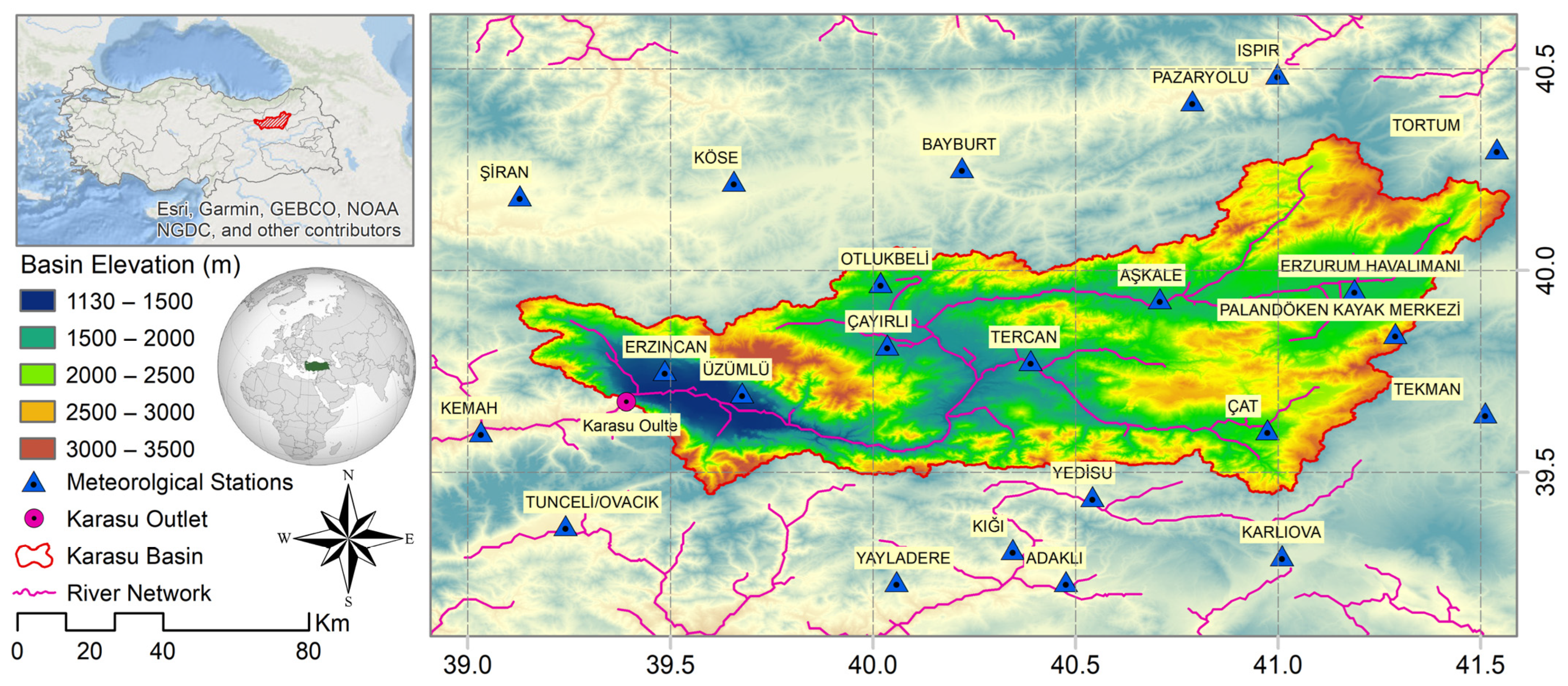
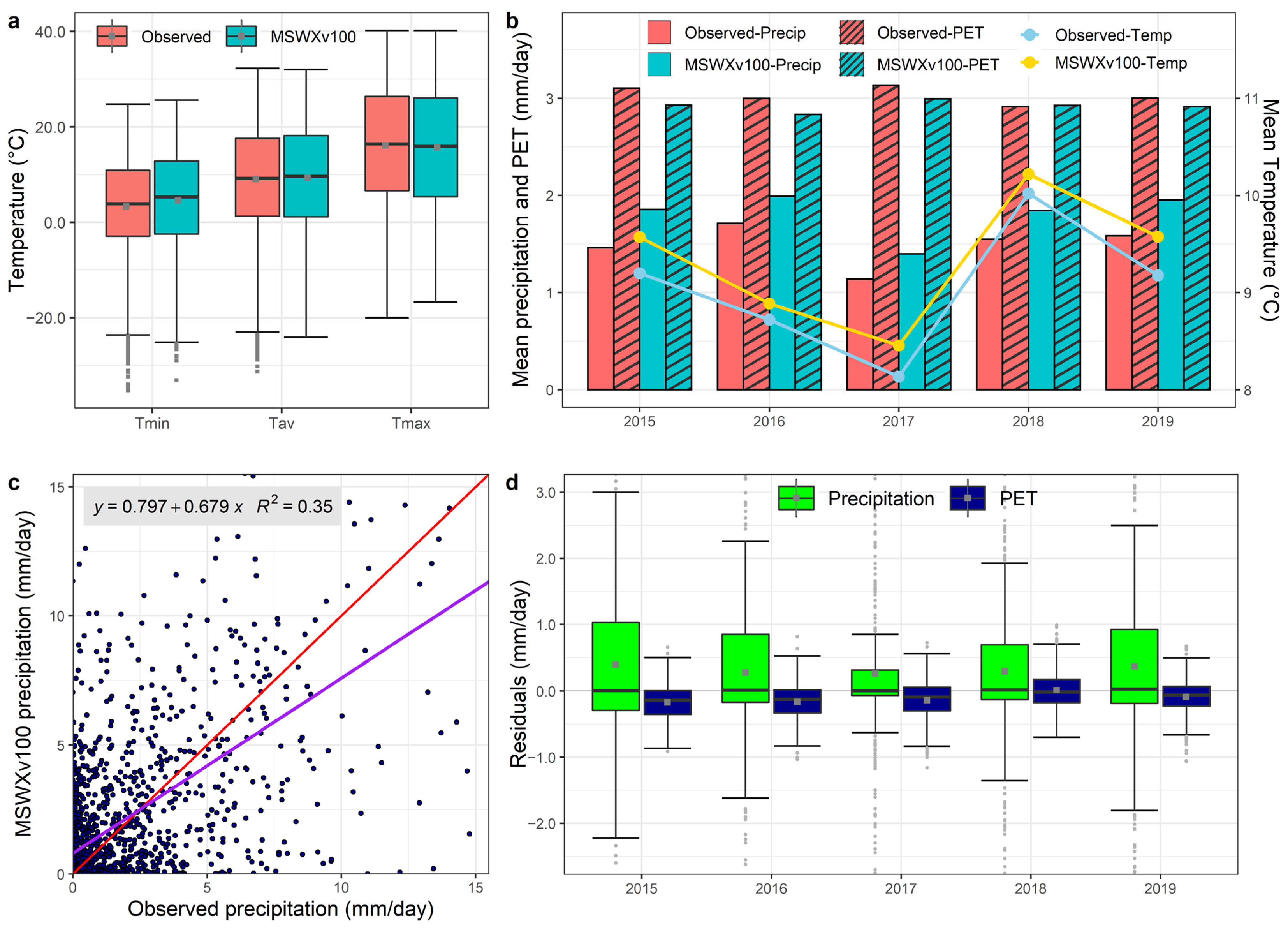
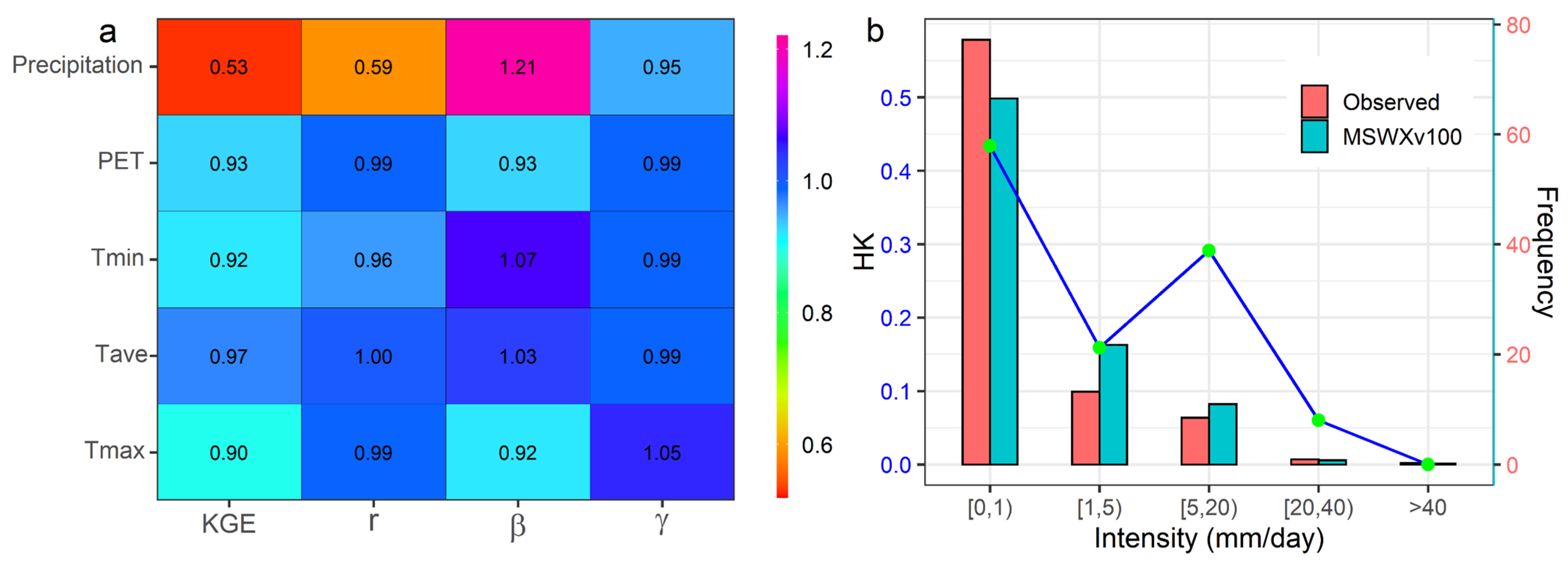
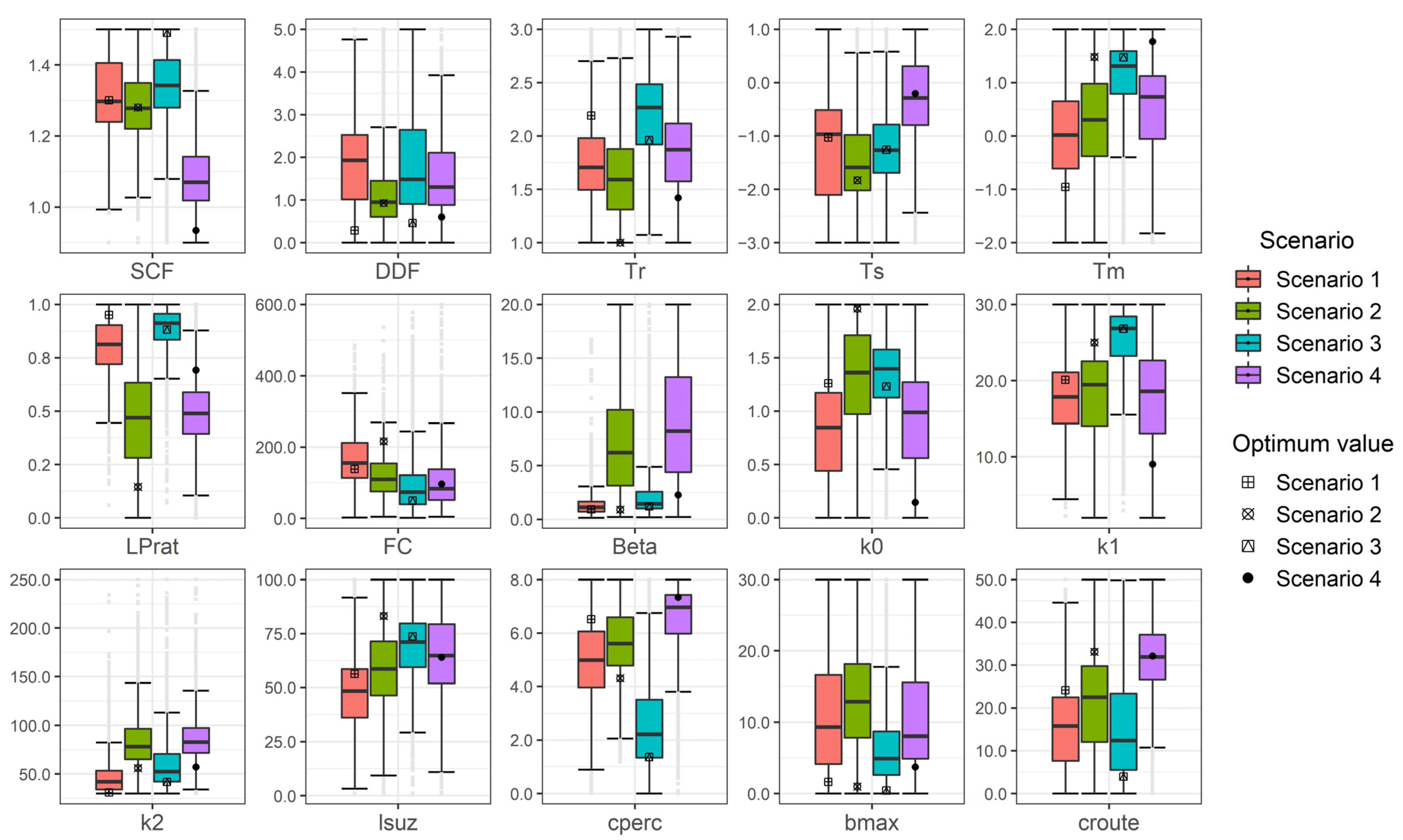
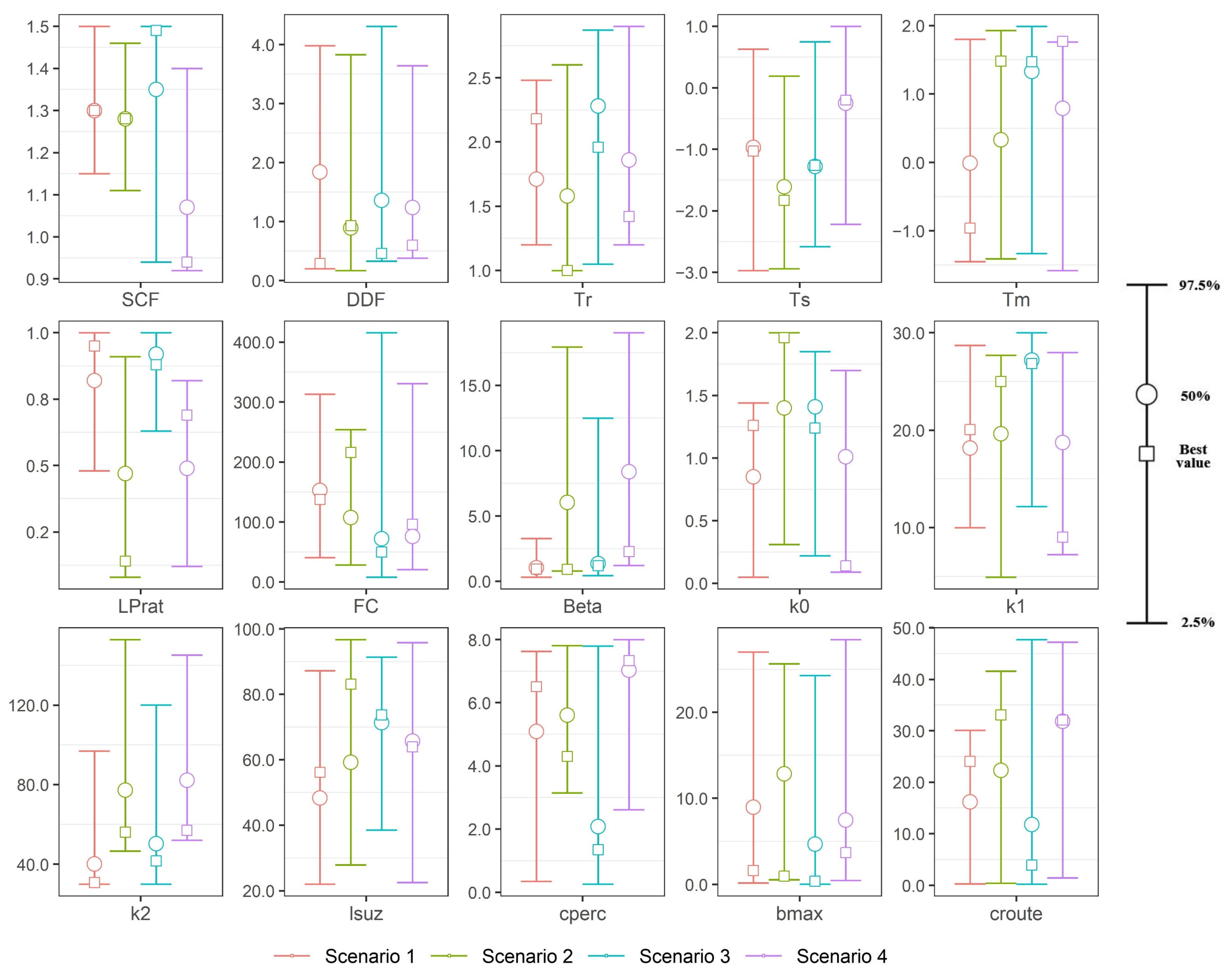
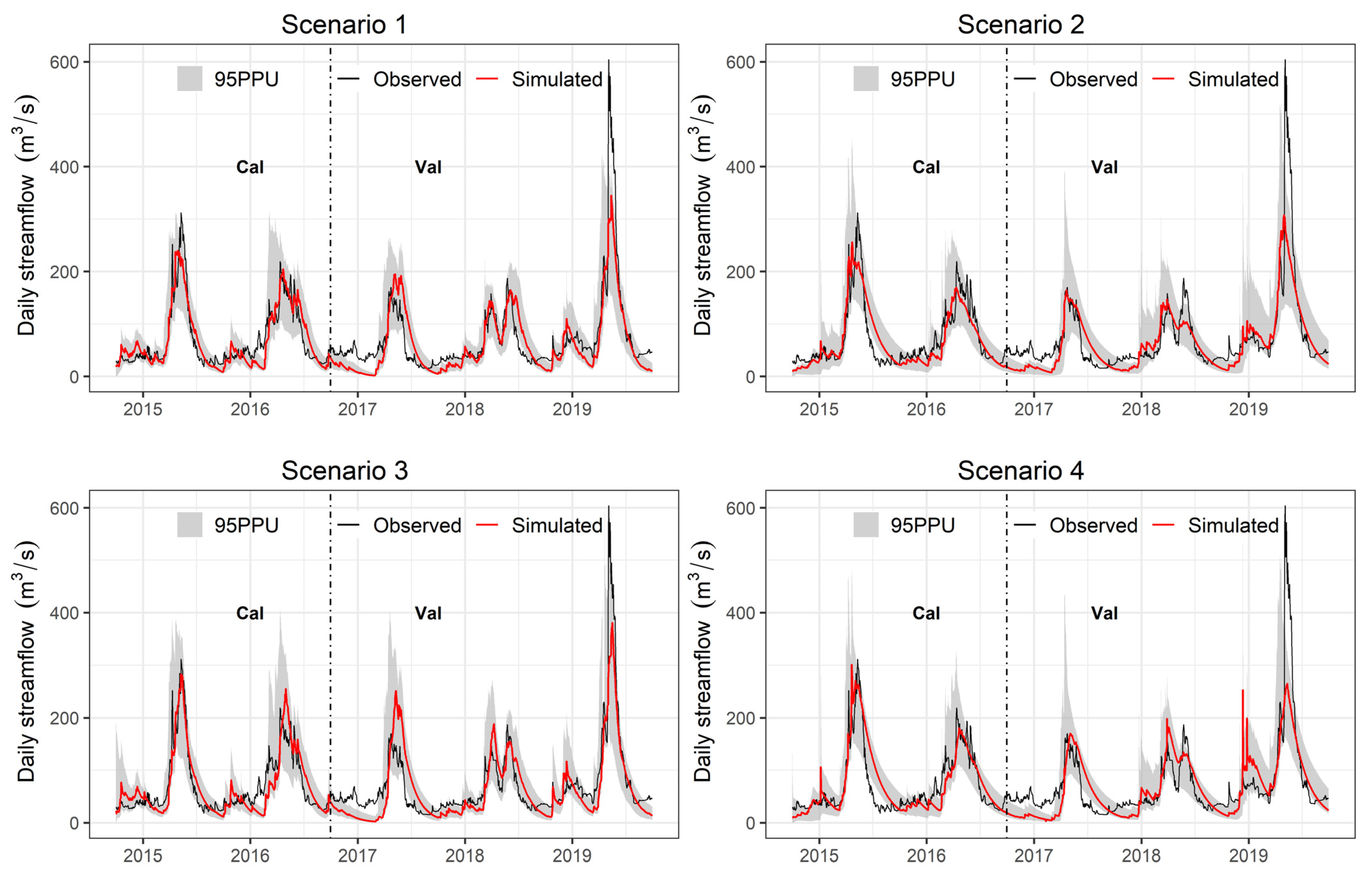

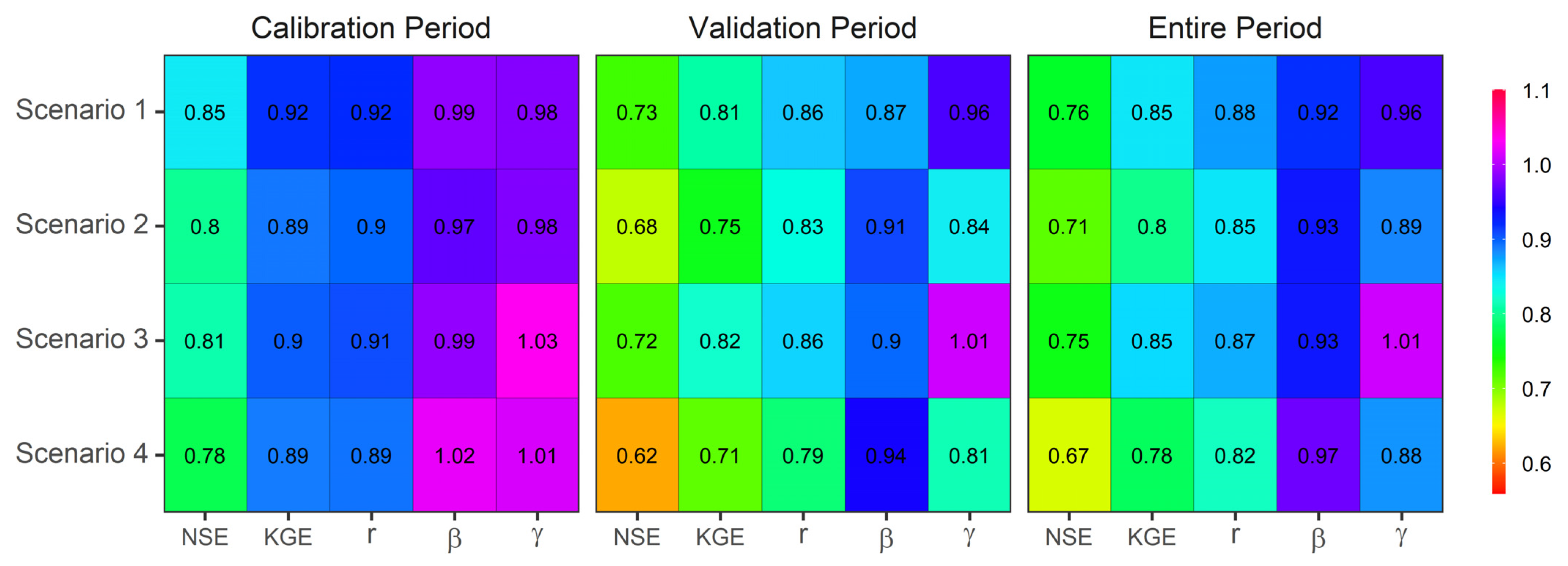
| ID | Description | Units | Process | Range |
|---|---|---|---|---|
| SCF | Snow correction factor | - | S | 0.9–1.5 |
| DDF | Degree-day factor | mm/°C /day | S | 0.0–5.0 |
| Tr | Temperature threshold above which precipitation is rain | °C | S | 1.0–3.0 |
| Ts | Temperature threshold below which precipitation is snow | °C | S | −3.0–1.0 |
| Tm | Temperature threshold above which melt starts | °C | S | −2.0–2.0 |
| LPrat | Parameter related to the limit for PET | - | SM | 0.0–1.0 |
| FC | Field capacity | mm | SM | 0.0–600 |
| BETA | Non-linear parameter for runoff production | - | SM | 0.0–20 |
| cperc | Constant percolation rate | mm/day | R | 0.0–8.0 |
| k0 | Storage coefficient for very fast response | day | R | 0.0–2.0 |
| k1 | Storage coefficient for fast response | day | R | 2.0–30 |
| k2 | Storage coefficient for slow response | day | R | 30–250 |
| lsuz | Threshold storage state | mm | R | 1.0–100 |
| bmax | Maximum base at low flows | day | R | 0.0–30 |
| croute | Free scaling parameter | day2/mm | R | 0.0–50 |
| P/R-Factors | Scenario 1 | Scenario 2 | Scenario 3 | Scenario 4 | Temporal | Time Window |
|---|---|---|---|---|---|---|
| P-factor | 0.84 | 0.74 | 0.84 | 0.78 | Calibration Period | 2015–2016 |
| R-factor | 1.24 | 1.28 | 1.30 | 1.27 | Calibration Period | 2015–2016 |
| P-factor | 0.66 | 0.58 | 0.66 | 0.60 | Validation Period | 2017–2019 |
| R-factor | 0.95 | 1.06 | 0.99 | 1.01 | Validation Period | 2017–2019 |
| P-factor | 0.73 | 0.65 | 0.74 | 0.67 | Entire period | 2015–2019 |
| R-factor | 1.05 | 1.13 | 1.09 | 1.09 | Entire period | 2015–2019 |
Publisher’s Note: MDPI stays neutral with regard to jurisdictional claims in published maps and institutional affiliations. |
© 2022 by the authors. Licensee MDPI, Basel, Switzerland. This article is an open access article distributed under the terms and conditions of the Creative Commons Attribution (CC BY) license (https://creativecommons.org/licenses/by/4.0/).
Share and Cite
Hafizi, H.; Sorman, A.A. Integrating Meteorological Forcing from Ground Observations and MSWX Dataset for Streamflow Prediction under Multiple Parameterization Scenarios. Water 2022, 14, 2721. https://doi.org/10.3390/w14172721
Hafizi H, Sorman AA. Integrating Meteorological Forcing from Ground Observations and MSWX Dataset for Streamflow Prediction under Multiple Parameterization Scenarios. Water. 2022; 14(17):2721. https://doi.org/10.3390/w14172721
Chicago/Turabian StyleHafizi, Hamed, and Ali Arda Sorman. 2022. "Integrating Meteorological Forcing from Ground Observations and MSWX Dataset for Streamflow Prediction under Multiple Parameterization Scenarios" Water 14, no. 17: 2721. https://doi.org/10.3390/w14172721
APA StyleHafizi, H., & Sorman, A. A. (2022). Integrating Meteorological Forcing from Ground Observations and MSWX Dataset for Streamflow Prediction under Multiple Parameterization Scenarios. Water, 14(17), 2721. https://doi.org/10.3390/w14172721






